Laissez les Bon Temps Rouler!
March 27 – April 3, 2023
Natchitoches, LA is an endearing community. We saw several signs in the area restaurants and gift shops saying “laissez les bon temps rouler” and we have to agree – good times do roll here! Their French connection goes back to when France founded Natchitoches in 1714.
 |
| Resurrection ferns, rather than Spanish moss, line the branches of live oak trees in this area! |
During our week in the area, we were told several different definitions of the word creole, one of them being if you are a descendant of someone born in colonial Louisiana. Another definition was if you have any French ancestors combined with either Spanish, Native American, or African. Yet another being any combination of French, Spanish, Native American, or African. Another being…. well, you get the idea. Everyone seemed to have their own idea of what creole is. I can tell you it not only describes a person, but also an entire culture unique to this area.
 |
| You find copies of Clementine's art everywhere! |
Figuring out how to pronounce Natchitoches was our first challenge! In case you are wondering, it’s “nack-a-dish”, which isn’t even close to how we were saying it! We got some pretty amusing looks from the locals as we slaughtered the name. It’s derived from the Natchitoches tribe that lived in the area. Natchitoches means “chinquapin eaters”, a type of chestnut found locally.
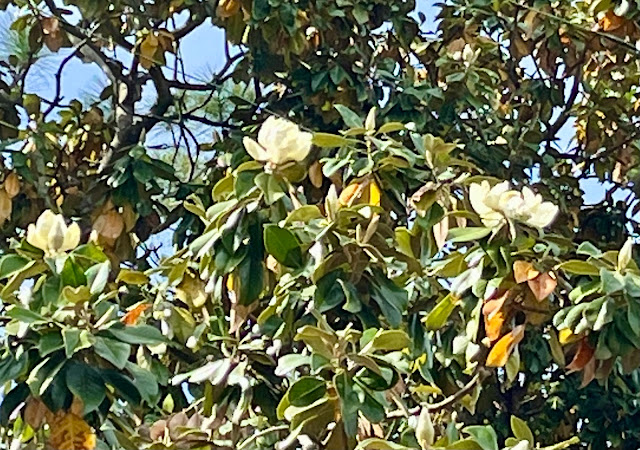 |
| Most of the magnolias will be blooming in a few weeks, but we did find a few early birds! |
The first thing that caught our attention was learning Natchitoches was the filming location for “Steel Magnolias”. Having last seen the movie when it was released in 1989, we thought it best to rewatch this dramatic comedy and refresh our memories a bit before heading to see the sites where the filming took place. Our camper isn’t set up with Wi-Fi, so we are dependent on either using our phone as a hotspot, or using whatever Wi-Fi the campground may offer in order to stream movies. It seems more often than not we aren’t successful, but this time it worked! Having our bellies exercised from laughter and our eyes moistened with tears, we took off to see for ourselves the locations where the magic happened. The Eatenton’s home is now a bed and breakfast. Wouldn’t it be fun to stay in the bedroom of Shelby (played by Julia Roberts)?
Right next door to the Eatenton home is the home of Ouiser (played by Shirley Mclaine). Ouiser is the classic grumpy old lady that you can’t help falling in love with! American Cemetery was only a short walk way. This had to be my favorite scene from the movie. Sally Field masterfully portraits a grieving mother (M’Lynn), surrounded by all of the strong women in her life. In this scene, Clairee (played by Olympia Dukakis) provides a shocking comic relief in offering up Ouiser as a punching bag for M’Lynn.
 |
| Ouiser's Church |
 |
| Susan Harling Robinson Memorial Park |
Speaking of shocking, we were stunned to learn this is a true story. Robert Harling (a Natchitoches native) wrote the story as a memorial for his sister, Susan Harling Robinson. The medical staff caring for Shelby in the film comprises the actual nurses and doctors that cared for Susan! There is a sweet memorial garden on the corner of Cypress Avenue and Pine Street telling the details of Susan’s struggle with diabetes. This small garden was used as a scene at the end of the film, where Ouiser and Clairee are making up following the punching bag chaos!
The film is jam-packed with great one-liners. Of course, you have to use the correct southern drawl when you say these lines! My favorite from Clairee is, “If you can’t say anything nice about anybody, come sit by me.” Dolly Parton played Truvy, the local hair dresser. Her line, “He’s so confused, he don’t know whether to scratch his watch or wind his butt,” makes me smile every time! Shelby’s “I would rather have 30 minutes of wonderful than a lifetime of nothing special” foreshadows what lay ahead.
We had to drive a bit to find the church where Shelby and Jackson were married. About 20 miles outside of town is St. Augustine Catholic Church, the site that was completely covered in pink for Shelby’s wedding. Blush and bashful were the wedding colors, which remain popular colors throughout town even today. One final piece of trivia: Robert Harling set the film in the fictional town of Chinquapin as a nod to the Natchitoches tribe.
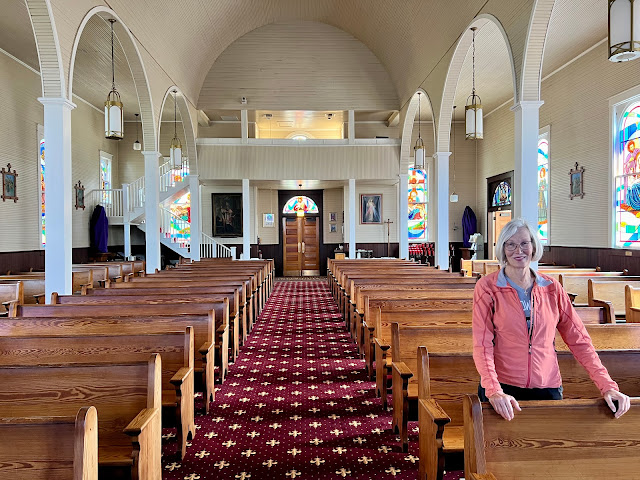 |
| Was this where Sally Field sat? |
While finding the site of the wedding was fun, the really cool thing about St. Augustine is that it is the first church built by and for free people of color in Louisiana and the second oldest in the US. In 1803, Augustine Metoyer and his brother, Louis Metoyer, donated the land and built the church. Augustine was born enslaved to Claude Thomas Pierre Metoyer, who eventually freed Augustine, Augustine’s mother and other children. Not only did Claude free them, he also gave each of them large parcels of land for establishing their own plantations. In fact, Louis went on to found Melrose Plantation, which is still considered one of the area’s jewels today.
In 1886, Clementine Hunter was born to a sharecropping family working at Melrose. Clementine worked as field hand at Melrose in her younger years, never learning to read or write. Later, she worked as a house keeper and eventually a cook. Melrose was owned by Cammie Hunter, who love the arts and would invite artists to come and stay at Melrose. While working as a cook in her early 50’s, Clementine discovered discarded paint an artist had left behind and began painting on various available surfaces such as window shutters, wine bottles, gourds, and cardboard boxes. The rest is history! It’s an incredible story, as Clementine is now considered one of the best self-taught American primitive artists! I loved learning that, if she liked someone/something, she would make them bigger. She loved chickens so, in her art, you find giant chickens pulling carts! You also could easily find the plantation overseer as he was very tiny in her paintings! Today, Clementine’s work is on display in many top museums, including The Louvre in Paris! Clementine lived to be 101 years old and is buried in St. Augustine’s cemetery.
 |
| This former tobacco barn, called the African House, houses Clementine's masterpiece! |
We also toured the Oakland and Magnolia Plantations, part of the Cane River Creole National Park Service. The park offers guided tours where we heard stories and were able to explore the buildings that still exist. These are two of the most intact Creole cotton plantations in the US! Touring the plantation store made it obvious that, although slavery had been abolished, slavery remained very much intact under the different names of sharecropping or tenant farming.
 |
| Live oaks make a path leading cool breezes from the Red River to Oakland's "Big House". |
 |
| The cotton gin at Magnolia Plantation survived the civil war; however, the "big house" was burned down. |
Natchitoches’ visitor center offered a historical walking tour of the historic downtown area, so we couldn’t resist the opportunity to learn a little bit more about the town. It’s really such a charming area! Cane River flows parallel to Front Street, which is filled with cute gift shops and boutiques.
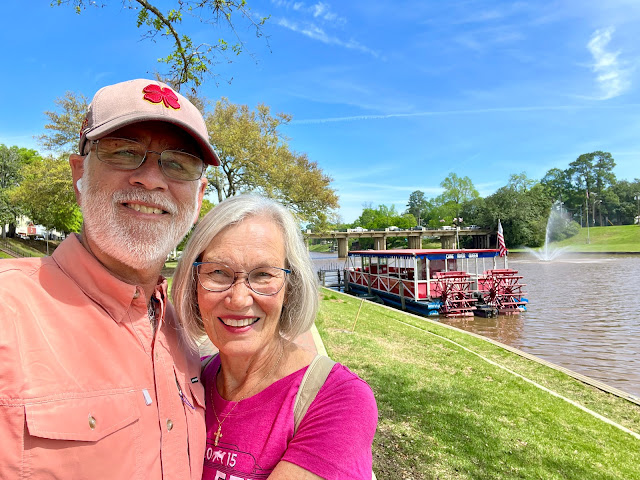 |
| Cane River Lake (long story but, yep, this portion of what was once the Red River is now a lake) |
On the tour, Jacob explained the significance of Natchitoches in the Louisiana Purchase and guided us past carriage ways (used by store owners to access the back of their stores), Kaffie-Frederick Hardware Store (the oldest hardware store in Louisiana), and explained all of the local history to us. Natchitoches is the oldest, continually occupied European settlement in the Louisiana Purchase! Sweet Fruit Delights (a little black-owned ice-cream shop on the corner) was the building where slaves were once sold. It was with such mixed emotions that we purchased ice-cream cones one hot afternoon. It felt good to support a black-owned business. At the same time, I couldn’t help imagining the terror enslaved people experienced there.
 |
| Inside Kaffie-Frederick Hardware Store -- I did manage to find something I needed! |
 |
| Louisiana Purchase map on the waterfront |
 |
| Inside one of the carriage ways. If you listen carefully, you might hear the clip-clop of horses! |
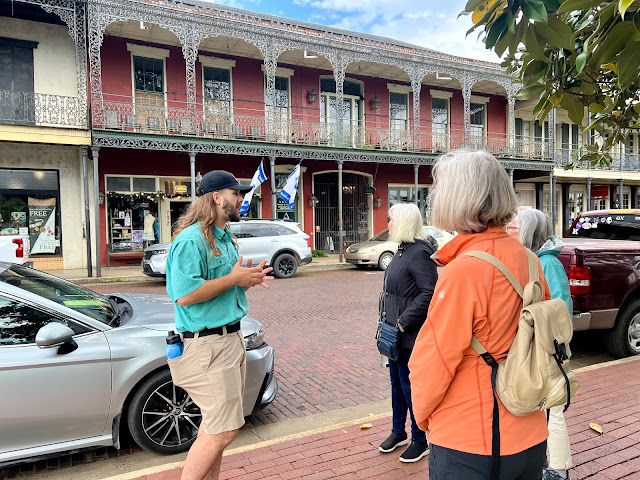 |
| Natchitoches was designed after New Orleans -- notice the original wrought iron! |
Doing a little further exploring on our own, we uncovered a spiral staircase built in France in 1853 and shipped to Natchitoches via the Cane River in 1856. It was fun picturing what life looked like in Natchitoches when this staircase arrived.
We also discovered Story Brew Coffee Café where we not only enjoyed a good cup of coffee, but I had the opportunity to try to redeem myself in a game of Battleship. BTW, I’m terrible at this game!
 |
| At least I lose graciously! |
Meat Pies are the center of attention when discussing local cuisine. It is chopped beef and pork, combined with savory seasoning and stuffed into a crescent-shaped mini pie crust and deep fat fried. Lasyone’s is said to be “world famous” for their meat pies so, of course, we had to try one. I did try another one at The Cane River Commissary a few days later, thinking maybe this thing grows on you, but don’t think I’ll be trying any more. It’s not terrible or anything. I just think there are better things on menus.
 |
| The red beans and rice, gumbo and cornbread were good options (and, yes, we both shared)! |
Grand Ecore was home during our stay and I certainly would highly recommend this RV park! It’s several miles outside of town and is located a couple of miles off the main road, but it was worth going a few miles for! It is a Corps of Engineers park, so that says something right off the bat! The campsites are large, spaced far apart and have full hook-ups, the bathrooms are clean, and the Wi-Fi even works! Home run!
 |
| The bellow of cattle in our "backyard" made me feel like we were back in Iowa! |
Up next: Little Rock, Arkansas!
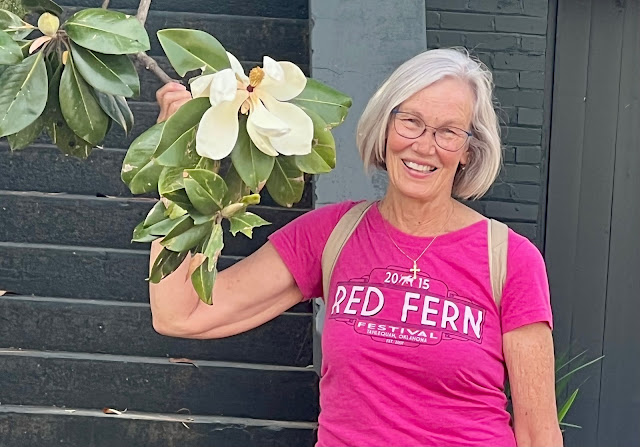
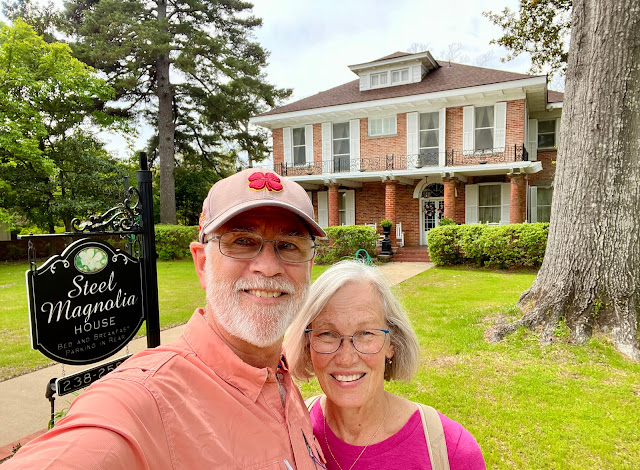






Comments
Post a Comment